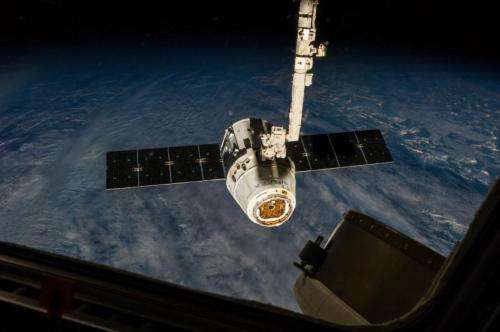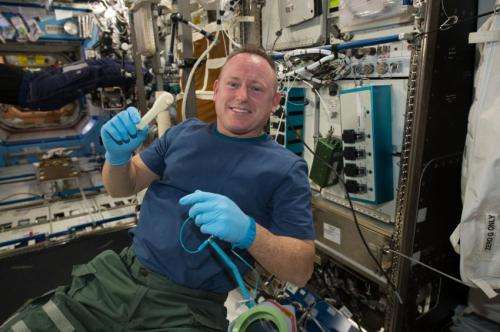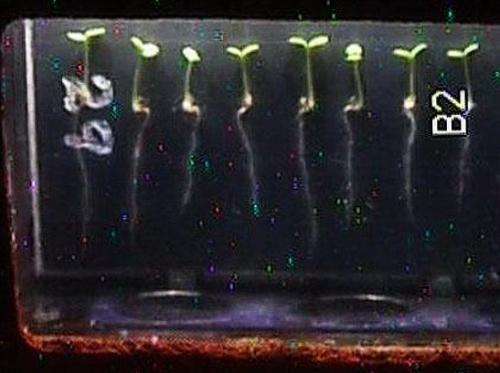Space station 3-D printed items, seedlings return in the belly of a Dragon

Newly 3-D printed wrenches, data to improve cooling systems, protein crystals and seedling samples returned Feb. 10 aboard SpaceX's fifth contracted resupply mission to the International Space Station. Researchers will use samples and data returned to improve scientific studies on Earth and build on research that will enable space exploration.
Printed parts and hardware returned from the first phase of operations for the 3-D Printing In Zero-G technology demonstration aboard the station. A study team from Made in Space and NASA demonstrated the first ever 3-D printer in space using relatively low-temperature plastic feedstock on the space station. To conclude the test phase, a ratchet wrench was printed using a design file transmitted from the ground to the printer.
"For the printer's final test in this phase of operations, NASA wanted to validate the process for printing on demand, which will be critical on longer journeys to Mars," explained Niki Werkheiser, the space station 3-D printer program manager at NASA's Marshall Space Flight Center in Huntsville, Alabama. Insight from demonstrations in microgravity also may help improve 3-D printing technology on Earth.
Many physical science investigations take place aboard the space station. Hardware and data from the recent Device for the study of Critical Liquids and Crystallization Alice Like Insert (DECLIC-ALI) returned aboard Dragon. On the orbital laboratory, researchers examined liquids at the verge of boiling to understand how the flow of heat in liquids behaves in microgravity. This is important to the development of cooling systems for space exploration with additional applications to waste disposal and recycling processes on Earth.

Samples, hardware and data from several biology and biotechnology studies returned with completion of this SpaceX contracted resupply mission. The Advancing Membrane Protein Crystallization by Using Microgravity (CASIS PCG HDPCG-2) investigation targeted producing high-quality crystals of the cystic fibrosis protein and other closely related proteins. Since many medically relevant proteins are difficult to crystalize on Earth, researchers attempt to grow them in space to help determine their shape and structure for drug development. Scientists hope to improve drug therapies for cystic fibrosis, a genetic disorder that causes severe damage to the lungs and digestive system.
The model plant Arabidopsis thaliana, or thale cress, seedlings feature heavily in these next three studies of which samples returned with the SpaceX Dragon. Growing model organisms like these to study plant biology in space may enable future space exploration by serving as a source of food and helping to create breathable air for astronauts.
Samples from the Advanced Plant Experiments 03-1 (APEX-03-1) were returned to help scientists better understand the effects of microgravity on the development of roots and cells on plant seedlings. Researchers will conduct a detailed analysis on the returned plant samples to scrutinize the molecular and genetic mechanisms that control plant development. With this knowledge, scientists may be able to improve agricultural and bioenergy research on Earth, leading to crops that use resources more efficiently.
Biological Research in Canisters (BRIC) hardware has supported a variety of plant growth investigations aboard the space station. Researchers will focus on what proteins are present in study samples from BRIC-20 grown in microgravity and compare them to ground control samples. With better understanding of how plant proteins enable plant survival in microgravity, scientists hope to improve process in agricultural production and generating biological energy on Earth.

And finally, samples from Seedling Growth-2 will help scientists determine the effects of microgravity and light on plant growth, development and cell production. The plants are grown in different wavelengths of light (red and blue), and both the plant growth and the expression of selected genes are compared to control plants on Earth.
"In the long term, these studies will aid in growing plants on space missions as well as on developing better crop species on Earth," said John Z. Kiss, Ph.D., principal investigator for Seedling Growth-2.
The scientific research delivered and returned by Dragon enables advances in every aspect of the diverse space station science portfolio, including biology and biotechnology, physical sciences and technology development and demonstration.
Provided by NASA





















